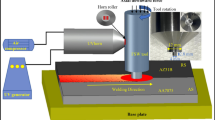Abstract
Titanium alloys are known to produce shear-localized chips during machining, resulting in cyclic variations in cutting forces which in turn could cause severe problems with vibrations. However, at low cutting speeds and feed rates, continuous chips are formed, with an increase in both parameters favoring the transition to shear-localized chips. This transition is affected by work material microstructure, where a coarse microstructure gives anisotropic effects, e.g., when the size of alpha colonies is on the same order of magnitude as the primary cutting zone. The change in chip morphology with an increase in cutting parameters will then be dependent on the orientation of alpha colonies within the cutting zone. The microstructure of work material can show large variations depending on product form, e.g., cast, wrought, or sheet material, thus affecting whether the chip formation is isotropic or anisotropic. Other sources of variations also exist that can be found within the same component, such as segregation of alloying elements and differences in thermo-mechanical history during processing due to geometry. In this study, the interaction between work material microstructure, process parameters, and the machining system’s structural characteristics is studied. The aim is to further increase the knowledge about vibrations during machining of titanium and the role of microstructure and machining system properties. Different microstructures were produced by adding boron to cast Ti-6Al-4V material, where the resulting colony sizes gave both isotropic and anisotropic chip formation within the chosen cutting data range. The machining systems dynamic properties were varied by using different tool overhangs, thereby simulating different configurations of natural frequencies and stiffness. The results show the influence of both microstructure and machining system’s structural characteristics on the dynamic response of the system for different process parameters. This information can be used to increase robustness of machining operations taking into consideration this three-way relationship.
Similar content being viewed by others
References
Destefani JD (1990) Introduction to titanium and titanium alloys, properties and selection, nonferrous alloys and special-purpose materials, vol 2. ASM Handbook. ASM International
Komanduri R, Hou ZB (2002) On thermoplastic shear instability in the machining of a titanium alloy (Ti-6Al-4V). Metall Mater Trans A Phys Metall Mater Sci 33(9):2995–3010
Quintana G, Ciurana J (2011) Chatter in machining processes: a review. Int J Mach Tool Manuf 51(5):363–376
Nakayama K (1974) The formation of “Saw-toothed Chip” in metal cutting. Proc Intern Conf on Production Eng, Tokyo, pp 572–577
Komanduri R, Von Turkovich BF (1981) New observations on the mechanism of chip formation when machining titanium alloys. Wear 69(2):179–188. doi:10.1016/0043-1648(81)90242-8
Vyas A, Shaw MC (1999) Mechanics of saw-tooth chip formation in metal cutting. J Manuf Sci Eng 121(2):163–172. doi:10.1115/1.2831200
Barry J, Byrne G, Lennon D (2001) Observations on chip formation and acoustic emission in machining Ti–6Al–4V alloy. Int J Mach Tool Manuf 41(7):1055–1070. doi:10.1016/s0890-6955(00)00096-1
Komanduri R, Brown RH (1981) On the mechanics of chip segmentation in machining. J Eng Ind 103(1):33–51
Komanduri R (1982) Some clarifications on the mechanics of chip formation when machining titanium alloys. Wear 76(1):15–34. doi:10.1016/0043-1648(82)90113-2
Cedergren S, Petti G, Sjöberg G (2013) On the influence of work material microstructure on chip formation, cutting forces and Acoustic emission when machining Ti-6Al-4V. Procedia CIRP 12:55–60. doi:10.1016/j.procir.2013.09.011
Andersson M (1993) Ytor, dynamik och mikrogeometrier: skärande bearbetning. Lund University,
Landberg P (1956) Vibrations caused by chip formation. Microtechnic 10(5):219–228
Budak E (1994) Mechanics and dynamics of milling thin walled structures. University of British Columbia,
Dornfeld D, Min S, Takeuchi Y (2006) Recent advances in mechanical micromachining. CIRP Ann Manuf Technol 55(2):745–768
Brecher C, Esser M, Witt S (2009) Interaction of manufacturing process and machine tool. CIRP Ann Manuf Technol 58(2):588–607. doi:10.1016/j.cirp.2009.09.005
Pederson R, Gaddam R, Antti M-L (2012) Microstructure and mechanical behavior of cast Ti-6Al-4V with addition of boron. Central Eur J Eng 2(3):347–357. doi:10.2478/s13531-012-0004-6
Singh G, Gaddam R, Petley V, Datta R, Pederson R, Ramamurty U (2013) Strain-controlled fatigue in B-modified Ti–6Al–4V alloys. Scr Mater 69(9):698–701. doi:10.1016/j.scriptamat.2013.08.008
Ståhl J-E (2012) Metal cutting: models and theories. SECO TOOLS AB, Fagersta
Tobias SA (1965) Machine-tool vibration. Blackie and Sons Ltd, London
Merchant M, Krabacher E, Young H, Miller J (1954) Titanium is unorthodox when machined… here’s why. Am Mach 98:118
Sun S, Brandt M, Dargusch MS (2009) Characteristics of cutting forces and chip formation in machining of titanium alloys. Int J Mach Tool Manuf 49(7–8):561–568. doi:10.1016/j.ijmachtools.2009.02.008
Zener C, Hollomon JH (1944) Effect of strain rate upon plastic flow of steel. J Appl Phys 15(1):22–32. doi:10.1063/1.1707363
Chan K (2004) A micromechanical analysis of the yielding behavior of individual Widmanstätten colonies of an α + β titanium alloy. Metall Mater Trans A 35(11):3409–3422. doi:10.1007/s11661-004-0177-6
Trent EM, Wright PK (2000) Metal cutting, 4th edn. Butterworth-Heineman, Woburn
Chan K, Wojcik C, Koss D (1981) Deformation of an alloy with a lamellar microstructure: experimental behavior of individual widmanstatten colonies of an α-β titanium alloy. Metall Mater Trans A 12(11):1899–1907. doi:10.1007/bf02643801
Guo YB (2003) An integral method to determine the mechanical behavior of materials in metal cutting. J Mater Process Technol 142(1):72–81. doi:10.1016/s0924-0136(03)00462-x
Pujana J, Rivero A, Celaya A, de Lacalle LN L (2009) Analysis of ultrasonic-assisted drilling of Ti6Al4V. Int J Mach Tool Manuf 49(6):500–508. doi:10.1016/j.ijmachtools.2008.12.014
Sisson TR, Kegg RL (1969) An explanation of low-speed chatter effects. J Manuf Sci Eng 91(4):951–958. doi:10.1115/1.3591778
Author information
Authors and Affiliations
Corresponding author
Electronic supplementary material
Below is the link to the electronic supplementary material.
Online Resource 1
High speed film of chip formation in coarse and fine microstructures. (MPG 88532 kb)
Rights and permissions
About this article
Cite this article
Cedergren, S., Frangoudis, C., Archenti, A. et al. Influence of work material microstructure on vibrations when machining cast Ti-6Al-4V. Int J Adv Manuf Technol 84, 2277–2291 (2016). https://doi.org/10.1007/s00170-015-7827-2
Received:
Accepted:
Published:
Issue Date:
DOI: https://doi.org/10.1007/s00170-015-7827-2




